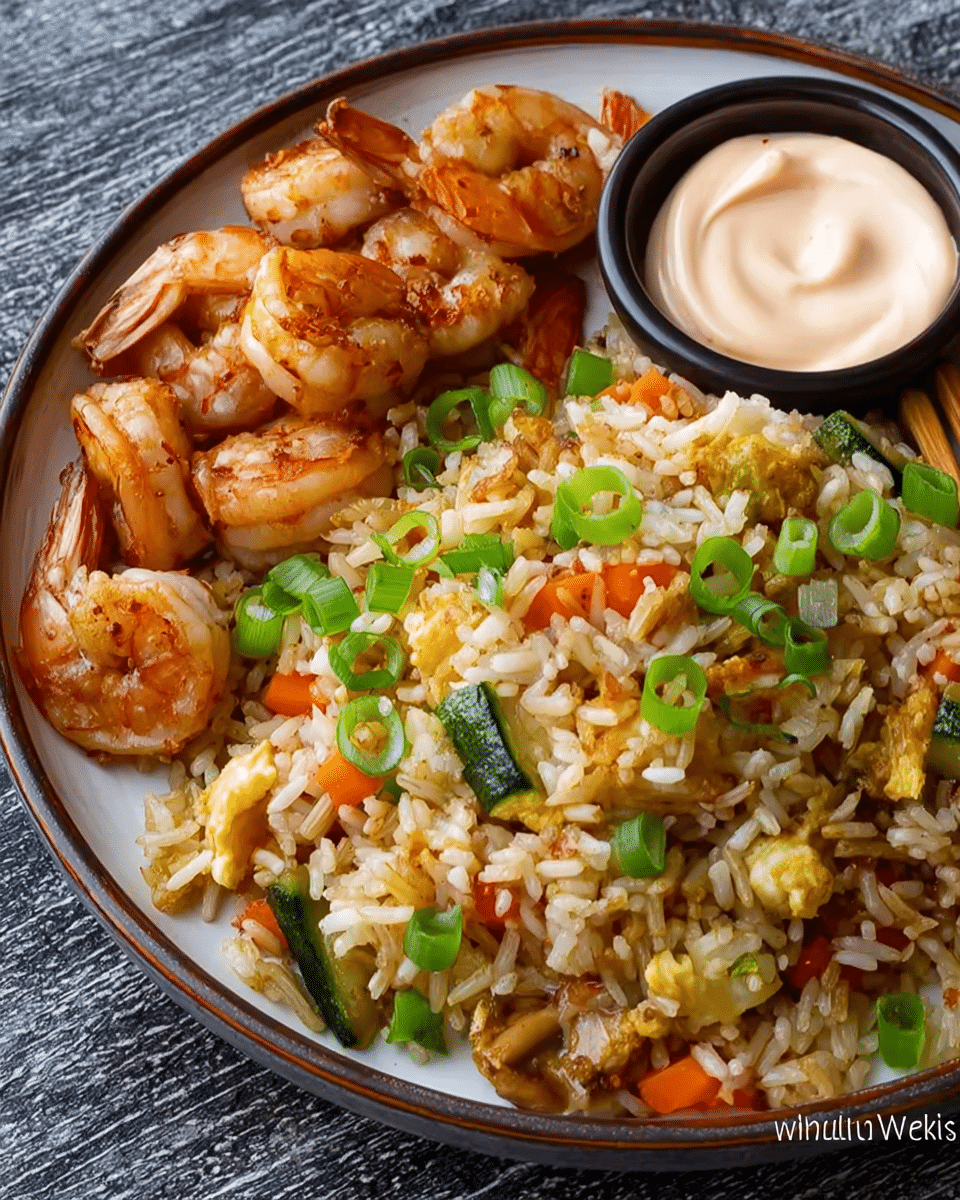Hibachi Fried Rice brings the vibrant flavors of Japanese cuisine straight to your kitchen in just 30 minutes. This dish combines cooked jasmine rice, shrimp (or your choice of protein), vegetables, and savory sauces, creating a flavorful and satisfying meal. Perfect for busy weeknights or casual gatherings, hibachi fried rice is easy to make and highly customizable.
Full Recipe:
Ingredients
-
3 cups cooked jasmine rice
-
1 cup shrimp, peeled and deveined
-
1 cup zucchini, sliced
-
1 cup mixed vegetables (carrots, peas)
-
4 pieces green onions, chopped
-
3 cloves garlic, minced
-
2 eggs, beaten
-
3 tablespoons soy sauce
-
2 tablespoons vegetable oil
-
1 tablespoon sesame oil
-
Salt to taste
-
Pepper to taste
Directions
-
Heat vegetable oil in a large skillet or wok over medium-high heat.
-
Add shrimp and cook for 2-3 minutes until they turn pink. Remove and set aside.
-
In the same skillet, add garlic and zucchini. Sauté for about 2 minutes until tender.
-
Push veggies to the side, crack in the beaten eggs, and scramble until cooked.
-
Add cooked rice, mixed vegetables, soy sauce, sesame oil, salt, and pepper. Stir to combine thoroughly.
-
Return the shrimp to the skillet, add green onions, and mix well. Cook for another 2-3 minutes to heat through.
-
Serve hot and enjoy!
Nutrients (per serving)
-
Calories: 450 kcal
-
Protein: 20-30g (depending on the protein used)
-
Fat: 15-20g
-
Carbohydrates: 45-60g
-
Fiber: 3-5g (based on added vegetables)
A Dish Rooted in Japanese Cuisine
Hibachi fried rice traces its roots to the popular hibachi-style cooking methods found in Japanese cuisine. Traditionally cooked on a flat grill, hibachi meals are known for their quick cooking times and vibrant flavors. The term “hibachi” is often used in the United States to describe a style of cooking involving high heat, where chefs skillfully cook food right before your eyes, typically on a flat-top griddle. The idea of hibachi fried rice stems from the practice of cooking rice in a wok or on a flat grill, where it’s tossed and cooked rapidly to absorb all the flavors of the ingredients.
In traditional hibachi dishes, rice is cooked alongside seasoned vegetables and proteins, creating a dish that’s not only delicious but also visually exciting as chefs toss the ingredients high into the air before serving them. While you may not have access to a hibachi grill at home, the same wonderful flavors and textures can be easily replicated using a regular skillet or wok, allowing you to enjoy the flavors of hibachi cooking in the comfort of your own kitchen.
The Role of Rice in Hibachi Fried Rice
The base of hibachi fried rice is the jasmine rice, which brings a fragrant, slightly floral quality that pairs perfectly with the savory ingredients. When preparing hibachi fried rice, it’s crucial to use day-old rice, as freshly cooked rice can become too soft and sticky when fried. The slightly drier texture of day-old rice ensures that each grain can be coated with the savory sauces, creating that delightful slightly crispy texture that is characteristic of fried rice.
Jasmine rice, with its long grain and delicate fragrance, provides the perfect foundation for this dish. While white rice is traditionally used, jasmine rice has a superior texture and flavor that takes hibachi fried rice to the next level. The rice absorbs the rich umami flavors of the soy sauce and sesame oil, resulting in a savory, satisfying bite every time.
Shrimp: A Popular Protein for Hibachi Fried Rice
Shrimp is a popular protein choice in hibachi fried rice, offering a light, delicate flavor that pairs wonderfully with the savory fried rice. When cooked properly, shrimp becomes tender and slightly sweet, and its mild flavor allows the other ingredients to shine through. Shrimp cooks quickly, making it an ideal protein for this fast-paced dish, ensuring that the entire meal can be prepared in under 30 minutes.
However, one of the best aspects of hibachi fried rice is its versatility when it comes to protein. If shrimp isn’t your preference, you can easily substitute it with chicken, beef, or tofu to cater to your personal tastes or dietary restrictions. Chicken offers a leaner alternative with a similar texture to shrimp, while beef brings a rich, hearty flavor. Tofu, on the other hand, is a great plant-based protein option, absorbing the savory sauces and becoming delightfully crispy on the outside.
Vegetables: Adding Color, Texture, and Nutrition
Vegetables are an essential component of hibachi fried rice, offering not only color and texture but also a nutritional boost. Zucchini, carrots, peas, and green onions are common additions, providing a satisfying crunch and slight sweetness that balances out the savory flavors of the rice and protein. The vibrant colors of the vegetables not only make the dish visually appealing but also contribute to its overall health benefits.
Zucchini is a particularly great addition because of its mild flavor and tender texture when cooked. It cooks quickly and absorbs the flavors of the seasonings beautifully. The carrots and peas bring natural sweetness, while the green onions offer a fresh, slightly sharp contrast to the richness of the soy sauce and sesame oil. This combination of vegetables ensures that each bite of hibachi fried rice is not only delicious but also full of nutritional value, providing fiber, vitamins, and antioxidants to the dish.
The Key to Hibachi Fried Rice: Soy Sauce and Sesame Oil
The secret to the bold, umami-rich flavor in hibachi fried rice lies in the use of soy sauce and sesame oil. Soy sauce provides the savory, salty base that defines the dish’s flavor, while sesame oil adds a toasty, nutty richness that enhances the overall taste profile. The combination of these two ingredients creates a harmonious balance of salty, savory, and nutty flavors, ensuring that the rice absorbs the perfect amount of seasoning.
Soy sauce is essential for adding depth to the dish, while sesame oil brings an unmistakable fragrance that is central to the dish’s flavor. The slight sweetness of sesame oil enhances the natural umami of the soy sauce, creating a satisfying sauce that coats each grain of rice and elevates the entire dish. These two ingredients are also the base for creating other variations of hibachi fried rice, depending on the choice of protein and vegetables.
Customizing Your Hibachi Fried Rice
One of the reasons hibachi fried rice is so popular is its versatility. While the basic recipe calls for shrimp, vegetables, and jasmine rice, you can easily adjust the ingredients to suit your personal preferences or dietary restrictions. The beauty of this dish is that it can be made with a wide variety of proteins and vegetables, allowing you to create endless variations of this flavorful dish.
For those looking for a vegetarian or vegan option, tofu can be substituted for shrimp or chicken, and additional vegetables like mushrooms, bell peppers, or broccoli can be incorporated for extra texture and flavor. You can also experiment with adding sauces like hoisin, oyster sauce, or sriracha to add complexity and spice to the dish.
If you’re looking for a healthier option, consider using brown rice instead of jasmine rice for added fiber and nutrients. You can also add more vegetables or use less oil to make the dish lighter while still maintaining its delicious flavors.
A Quick and Satisfying Meal
Hibachi fried rice is the perfect solution for busy weeknights or casual gatherings. The dish comes together quickly, typically in under 30 minutes, making it ideal for those who want a hearty meal without spending too much time in the kitchen. It’s also an excellent way to use up leftover rice, ensuring that nothing goes to waste.
Whether you’re serving it as a main dish or as a side to complement other Asian-inspired dishes, hibachi fried rice is a crowd-pleaser that satisfies all appetites. Its balance of protein, vegetables, and savory rice makes it both a fulfilling and nutritious meal option that’s suitable for a variety of occasions.
Conclusion: A Deliciously Quick and Versatile Dish
Hibachi fried rice is a flavorful and versatile dish that can be easily adapted to suit various tastes and dietary preferences. Whether you choose shrimp, chicken, tofu, or beef, the combination of savory soy sauce, nutty sesame oil, and perfectly cooked vegetables makes hibachi fried rice a satisfying and delicious meal. With its quick preparation time and customizable ingredients, this dish is perfect for busy weeknights, casual dinners, or special occasions.
The rich umami flavors, satisfying texture, and ease of preparation make hibachi fried rice a staple in many kitchens. Whether served on its own or paired with other dishes, it’s a simple yet delightful way to enjoy the vibrant flavors of Japanese-inspired cooking.






